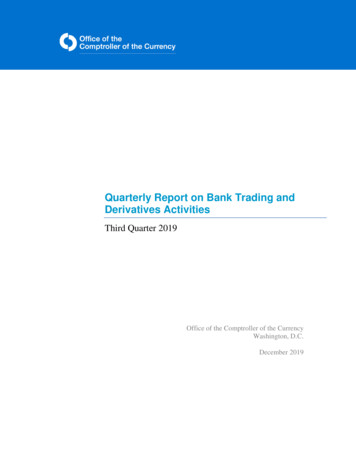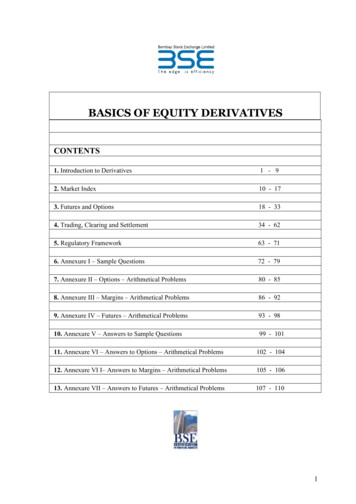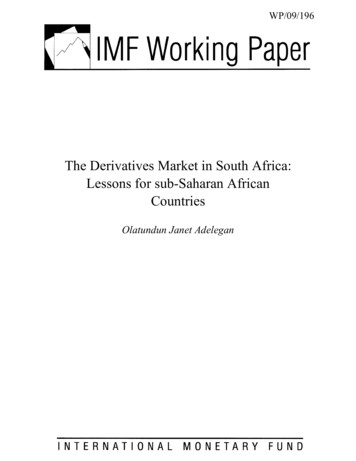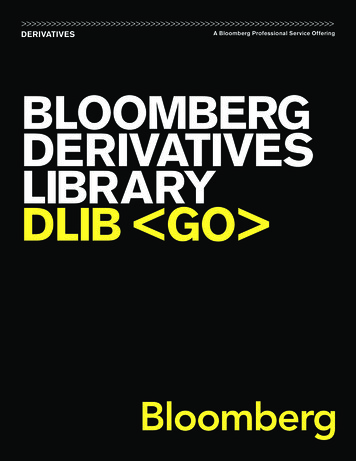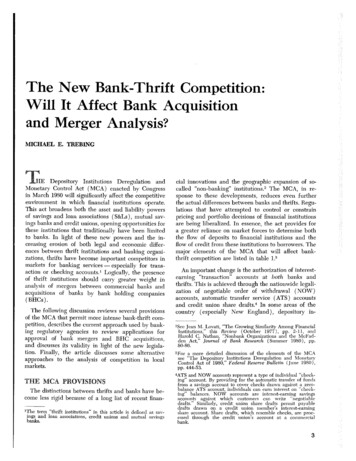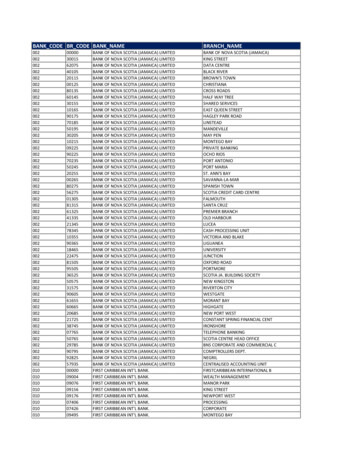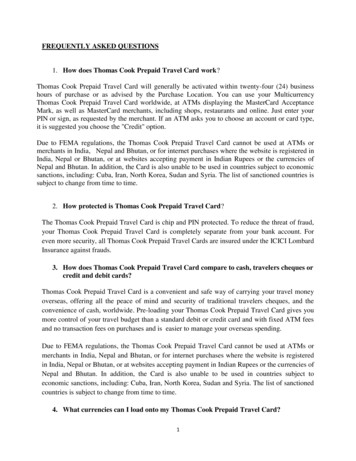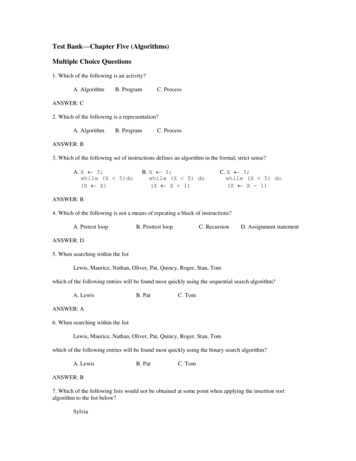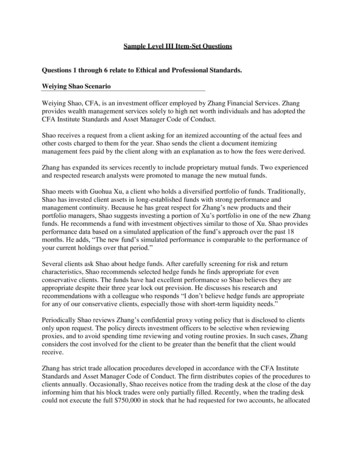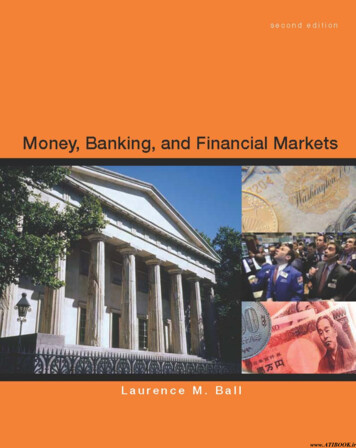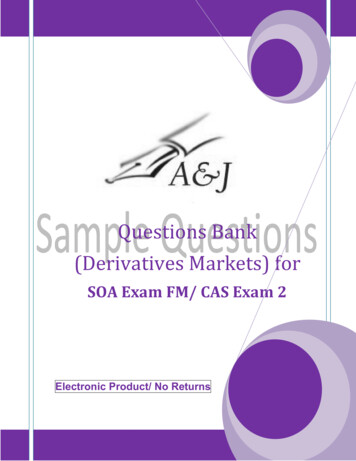
Transcription
Questions Bank(Derivatives Markets) forSOA Exam FM/ CAS Exam 2Electronic Product/ No Returns
PrefaceSOA Exam FM/ CAS Exam 2PrefaceEver since the material of Derivatives Market is included, exam FM/2 is no longer testing thecandidates purely on the classical theory of interest, and, from the response of most candidates, theexam has become tougher than before. To many candidates, numerous graphs, jargons,apparently-similar yet different terms and concepts are rather confusing and hard to comprehend.Facing these challenges, the candidates still need to find out the potential questions asked in theexams. Most candidates find it relatively easy to understand the material on theory of interest, andthe questions on the material can be easily obtained from the past year exam questions, unlike thematerial on derivatives market, which is scarce and not available in the market. This makes itharder for the candidates to know what to expect in the exam.Attributable to this, this questions bank is specially written to assist candidates who face difficulty inthe material. It consists of 180 questions covering the required readings in the textbook by RobertMcDonalds. The questions test the candidates both the calculation skills and the comprehension ofthe concepts. With all my best, I have attempted to exhaust from pages to pages of the textbook allthe potential questions that can be raised in the exam. I believe that this can help the candidates tounderstand the material tremendously.Should you have any questions, feel free to raise them to me at anjstudymanual@gmail.com. I willreply you in 1-3 business days. You can also add me in your contact list of messenger for furtherclarification of your problems. However, do send me an email before contacting me directly throughmessenger.All the best for the exam, and enjoy the reading.Alvin SohndCopyright 2010 A&J Study Manual. 2 Edition 2
Table of ContentsSOA Exam FM/ CAS Exam 2Table of ContentsPart 1: Introduction on Derivatives and Risks . 4Answer keys . 5Solutions . 5Part 2: Forward Contracts and Options . 6Answer Keys . 13Solutions . 13Part 3: Insurance and Other Option Strategies . 19Answer Keys . 32Solutions . 32Part 4: Application of Derivatives- Risk Management . 40Answer Keys . 53Solutions . 53Part 5: Financial Forwards and Futures . 61Answer Keys . 72Solutions . 72Part 6: Swaps . 79Answer Keys . 86Solutions . 86Author’s Biography . 91ndCopyright 2010 A&J Study Manual. 2 Edition 3
Part 1: Introduction on Derivatives and RisksSOA Exam FM/ CAS Exam 2Part 1: Introduction on Derivatives and Risks1. Which of the followings cannot mitigate credit risk?(A) Collateralization(B) Bank letters(C) Haircut(D) Hedging(E) No answer is given in (A), (B), (C), and (D)ndCopyright 2010 A&J Study Manual. 2 Edition 4
Part 1: Introduction on Derivatives and RisksSOA Exam FM/ CAS Exam 2Answer keys12345DECDESolutions1. Collateralization is to pledge a liability using assets. It definitely reduces the exposure of creditrisk. Bank letters is the acknowledgement letter from bank, which gives guarantee to thecreditors on the payment of the debtors. Haircut is similar to collateralization, which is used inshort sales.Hedging mitigates the market risk but not credit risk. For example, a gold seller hedges the goldprice by purchasing a put option. That does not protect the gold seller from the probability thatthe buyer is unable to pay for the gold. The answer is (D).ndCopyright 2010 A&J Study Manual. 2 Edition 5
Part 2: Forward Contracts and OptionsSOA Exam FM/ CAS Exam 2Part 2: Forward Contracts and Options1. You are given that the ABC Stock price is traded at 45 now and the 3-month forward price is 46.80. Which of the following is true about outright purchase of this stock and the forwardcontract?(A) If the spot price is 45 after 3 months, the profit for outright purchase and long forward contractis the same(B) If the spot price is 46.80 after 3 months, the profit for outright purchase and long forwardcontract is the same.(C) If the ABC Stock pays a dividend of 0.50 after 1 month and is traded at 46.80 after 3 months,purchasing the stock outright makes a profit of 2.30.(D) If the ABC stock pays a dividend of 0.50 after 1 month and is traded at 46.80 after 3 months,the profit of long forward is 0.(E) The answer is not given in (A), (B), (C), and (D).2. The current price of the Lucky Company Stock is 50, and the 6-month forward price is 52.What is the amount of money that needs to be lent today to mimic the profit of outright purchaseafter 6 months? Assume that the annual continuously compounded risk free rate is 5%.(A) 50.00(B) 50.20(C) 50.70(D) 51.20(E) 52.003. A dealer has just entered into a short forward position. The underlying asset is currently tradedat 100 and the 1-year forward price is 105. Assuming an annual effective rate of 3%, find thenumber of 100 zero-coupon bonds that the dealer has to buy to hedge his position.(A) 0.00000(B) 0.19417(C) 0.98058(D) 1.019417(E) 2.000004. Which of the following is false?(A) Entering into a long forward contract with a purchased zero-coupon bond maturing at theexpiration date of forward mimics the payoff of an outright purchase of stock(B) Purchasing a stock and borrowing the present value of forward price replicate a long forwardcontract(C) Entering into a long forward contract, selling a stock and buying a bond are always making anegative profit, since there is transaction cost.(D) Selling a stock and lending money at certain risk free rate earns the same payoff as a shortforward contract(E) Forward contracts are the only derivative that has no credit risk involvedndCopyright 2010 A&J Study Manual. 2 Edition 6
Part 2: Forward Contracts and OptionsSOA Exam FM/ CAS Exam 2Answer 3242526AECDEBEDCEBCCCAASolutions1. (A) is incorrect, because the profit for outright purchase is 0, whereas the profit of theforward contract is - 1.80. (B) is incorrect, since the profit for outright purchase is 1.80,whereas the profit for long forward contract is 0. (C) is incorrect, because the cashdividend is payable after 1 month. Due to time value of money, the profit for stock outrightpurchase is 1.80 0.50e0.1667r 2.30, when r 0. (D) is correct, since the forwardcontract is not directly affected by dividend paid before the date of maturity. So, the answeris (D).2. The answer is (C). Remember that the payoff of a forward contract is equivalent topurchasing a stock at expiration plus paying cash of the forward price. In order to achievethis, the present value of the forward price needs to be lent (buy bond) so that at expirationdate, the money lent will grow to the forward price. Therefore, the money that needs to belent today is 52e-0.05(0.5) 50.7161.3. To hedge the position of a short forward, we need to replicate a long forward contract. Thisrequires selling bonds (borrowing money) today so that there will be cash outflow at theexpiration date. Hence, the dealer needs to borrow the present value of the forward price: 105/1.03 101.9417, which is 1.019417 unit of a 100 zero-coupon bond. The answer is(D).4. The answer is (E). All derivatives involve credit risk. It is just the matter of exposure of therisk. For example, for forward contract, the short forward faces the credit risk that the buyeris unable to pay for the underlying asset.ndCopyright 2010 A&J Study Manual. 2 Edition 7
Part 3: Insurance and Other Option StrategiesSOA Exam FM/ CAS Exam 2Part 3: Insurance and Other Option Strategies1.A dealer has just entered into a derivative contract with a customer. The customer is obligatedto sell the underlying asset to the dealer at the expiration date at price K. The dealer wishes tofully hedge his position by trading the following derivatives. Which of the followings achieveshis goal?(A)(B)(C)(D)(E)Purchase a put option with strike price KSell a call option with strike price KPurchase a K-strike call and sell a K-strike putSell a K-strike call and purchase a K-strike putEnter into a long forward contract with forward price at K2.A dealer has just entered into a derivative position with a customer. The customer is obligatedto sell the underlying asset to the dealer if the spot price at expiration is more than K, whereasthe dealer has the right to sell the underlying asset to the customer if the spot price atexpiration is less than K. Which of the followings describes the derivative trading?(A)(B)(C)(D)(E)The dealer purchases a K-strike call and a K-strike putThe dealer sells a K-strike call and purchases a K-strike putThe dealer purchases a K-strike call and sells a K-strike putThe dealer sells a K-strike call and a K-strike putThe dealer enters into a long forward contract3.Alan has just entered into a derivative position with a dealer. The dealer makes a positivepayoff when the price of underlying asset is less than 35 and higher than 45 at expiration.Which of the followings describes the option strategy that the dealer has entered into?I. 35-45 purchased strangleII. 35-45 written strangleIII. 35-40-45 butterfly-spreadIV. 35-45 Bull call spread(A)(B)(C)(D)(E)I, IIIII, IIIII, IVIII, IVNo answer is given in (A), (B), (C), and (D)ndCopyright 2010 A&J Study Manual. 2 Edition 8
Part 3: Insurance and Other Option StrategiesSOA Exam FM/ CAS Exam 2Answer s1. “Obligation to sell the underlying asset to the dealer” implies that the customer is in the shortposition on the forward contract. The dealer is then in the long forward position. To hedgethis position, the dealer needs a short forward contract. Since selling a call option andbuying a put option with the same strike price of K replicates a short forward position, (D) isthe answer.2.“The customer is obligated to sell the underlying asset to the dealer if ” implies that thecustomer is writing an option. “ if the spot price at expiration is more than K” implies thatthe option is a call option. “The dealer has the right to sell the underlying asset to thecustomer if ” implies that dealer is purchasing an option. “ if the spot price at expiration isless than K” implies that the trader purchases a put option. This means, the dealerpurchases a K-strike call option and a K-strike put option. The answer is (A).3.A strangle bets on the volatility of the underlying asset price. A 35-45 purchased stranglemakes payoff when the spot price of underlying asset at expiration is not between 35 and 45. A 35-45 written strangle is just the opposite. 35-40-45 butterfly spread has almost thesame payoff as written straddle, just that the payoff from 0-35 and 45 to infinity is zero. 3545 Bull call spread makes 0 profit if it is less than 35, and 5 when it is more than 45.Hence, the answer that fulfils the requirement is I only. The answer is (E).ndCopyright 2010 A&J Study Manual. 2 Edition 9
BiographySOA Exam FM/ CAS Exam 2Author’s BiographyAlvin Soh was born in Penang, Malaysia. He is now a final year campus student studying in PetalingJaya, Malaysia. He is keen in sharing and helping his peers in actuarial exams. His strong passion inmathematics and actuarial career is reflected in his fast progress in actuarial exams. He has passedall the preliminary exams in the mere 1.5 years and he is more than willing to share his study methodsand experience to every actuarial student striving to progress in exams. He has passed an advancedlevel exam (Exam AFE) recently, and is pursuing his CERA and FSA in Finance and Enterprise RiskManagement.The following is the progress of his exams:Exam PassedP/1- ProbabilityFM/2- F
the material. It consists of 180 questions covering the required readings in the textbook by Robert McDonalds. The questions test the candidates both the calculation skills and the comprehension of the concepts. With all my best, I have attempted to exhaust from pages to pages of the textbook all the potential questions that can be raised in the exam. I believe that this can help the candidates to
